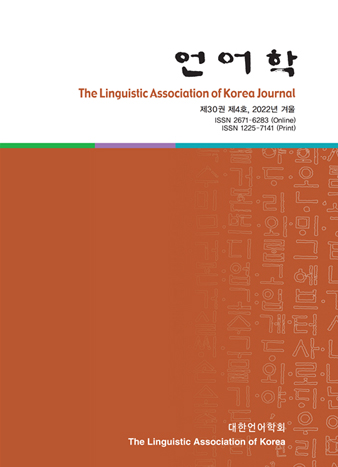대한언어학회 전자저널

30권 4호 (2022년 12월)
- 한국어 보조사 ‘-도’의 초점영역확장에 대한 연구
-
조기현
Pages : 85-103
Abstract
Joh, Gi-Hyun. (2022). A study of focus domain expansion in the Korean delimiter ‘-do’ construction. The Linguistic Association of Korea Journal, 30(4), 85-103. This paper aims to investigate the focus domain expansion phenomenon in the Korean delimiter ‘-do’ construction. For this, Chung(2021)’s oblique merge analysis is critically reviewed, the main idea of which is that thematic elements of a verb are formed as a complex focus cluster via the oblique merge operation in overt syntax. I point out that potential problems arise from the oblique merge operation itself, including binding, c-command, case licensing, and adverb interruption. I argue that the problems with Chung‘s oblique merge analysis are fundamentally caused by the systematic limit under the presupposed head-final structure for Korean. As an alternative, I propose that under the head-initial structure for Korean, the focus complex elements in question can be derived by raising the Del(imiter)P to the focus element, or a chain can be formed between the focus element and the DelP by the movement of the null operator of ‘-do,’ in either case by QR at LF.
Keywords
# 보조사구(delimiter phrase) # 핵어선(head-initial) # 양화사 이동 (quantifier raising) # 초점영역(focus domain expansion) # 사선적 병합 (oblique merge)
References
- 이정식. (2016). 국어 통사구조 새로 보기: 핵어선 구조의 관점에서. 서울: 한국문화사.
- 이정식, 조기현. (2016). 국어 조각구에 대한 분석. 언어학 연구, 39, 231-250.
- 정대호. (2021). 한국어 다중초점구문과 사선적 일치/병합. 서울: 한국문화사.
- An, D.-H. (2015). An alternative possibility for focus domain expansion: A reply to Chung 2014. Studies in Generative Grammar, 25(1), 321-332.
- Chung, D.-H. (1997). WH-scope identification via quasi-binding. Japanese/ Korean Linguistics, 7, 293-302.
- Chung, D.-H. (2015). An oblique merge analysis of multi-elemental fragment answers in Korean. In Proceedings of the 17th Seoul International Conference on Generative Grammar, 68-93.
- Kayne, R. (1994). The antisymmetry of syntax. Cambridge, MA.: MIT Press.
- Koizumi, M. (1995). Phrase structure in minimalist syntax. doctoral dissertation, MIT, Cambridge, MA.
- Takano, Y. (2002). Surprising constituents. Journal of East Asian Linguistics, 11, 243-301.
- Watanabe, A. (1992). Subjacency and s-structure movement of wh-in-situ. Journal of East Asian Linguistics, 1, 255-291.